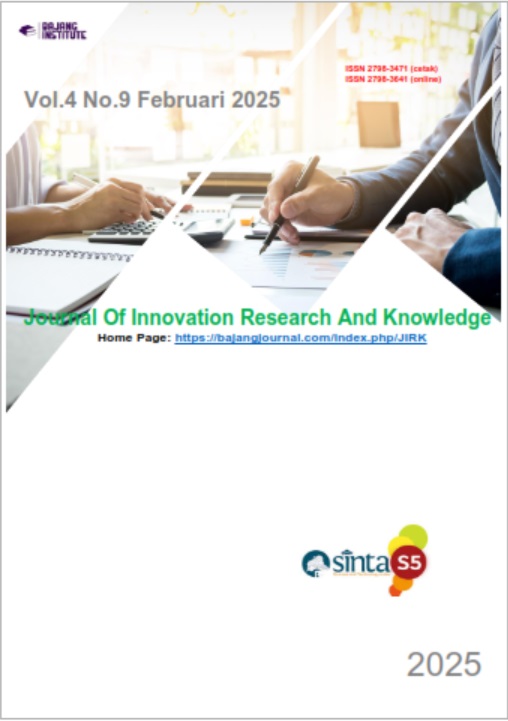HUBUNGAN SELF-EFFICACY DENGAN TINGKAT KECEMASAN LANSIA PADA DIABETES MELITUS DI RUMAH SAKIT MITRA MEDIKA TANJUNG MULIA
DOI:
https://doi.org/10.53625/jirk.v4i9.9693Keywords:
Self-Efficacy, Anxiety Level, Elderly, Diabetes MellitusAbstract
Elderly persons with poor self-efficacy are likely to be depressed or give up quickly, are dissatisfied with their circumstances, and have a reduced ability to act. This study aimed to determine the relationship between self-efficacy and elderly anxiety level in diabetes mellitus at Mitra Medika Hospital Tanjung Mulia Medan. The correlational design was used in the study, with analytic observations made using a cross-sectional design. The purposive sampling methodology obtained 88 respondents, who were tested using the chi square method. The instrument used three categories of data: primary data, secondary data, and tertiary data, Based on the statistical results in the pearson chi-square section, the value of a simp.Sig was 0.003. Because the þ value (0.003) < α (0.05), it can be concluded that there was a significant relationship between self-efficacy and elderly anxiety level in diabetes mellitus at Mitra Medika Hospital Tanjung Mulia Medan. The results showed that there is a significant relationship between self-efficacy and diabetes mellitus at Mitra Medika Hospital Tanjung Mulia Medan. It is suggested that this research be used as input and knowledge for self-efficacy and anxiety levels, since diabetes mellitus is critical for preventing DM wounds.
References
K THA, Ningsih SR, Akbar H, Fauzan MR, Rumaf F, Kesehatan FI, et al. Jurnal Inovasi Kesehatan, Volume 4 Nomor 1 ( Oktober 2022 ) Penerbit : Sekolah Tinggi Ilmu Kesehatan Papua ISSN 2686-5084 Hubungan Efikasi Diri Dengan Kualitas Hidup Pada Lansia Penderita Diabetes Mellitus Di Rumah Sakit X Kotamobagu Jurnal Inovasi Keseh. 2022;4(Oktober):22–5.
Salam AY, Hamim N. Foot Self Efficacy dan Foot Self Care Behaviour pada Lansia dengan Diabetes Melitus. JI-KES (Jurnal Ilmu Kesehatan). 2019;3(1):12–8.
Putra PWK, Suari KP. Hubungan Self Efficacy dan Dukungan Sosial terhadap Self Care Management Pasien Diabetes Mellitus Tipe II. Indonesia J Perawat. 2018;3(1):51–9.
Fhauzhyah. Hubungan Self Efficacy dengan Kualitas hidup Lansiadi dusun Polaman Desa Argorejo Sedayu, Yogyakarta. Hub Self Efikasi dengan Kualitas Hidup Lansia di Dusun Polaman Desa Argorejo Sedayu Yogyakarta. 2017;1(10):2–5.
Zhou, Yang, Wang. HUBUNGAN SELF EFFICACY DENGAN KUALITAS HIDUP PASIEN DIABETES MELITUS TIPE 2 DI PUSKESMAS OEBOBO KOTA KUPANG. file:///C:/Users/VERA/Downloads/ASKEP_AGREGAT_ANAK_and_REMAJA_PRINT.docx. 2020;21(1):1–9.
Putri CR. Pengaruh Self Help Group Terhadap Self Efficacy Penderita Diabetes Melltus Tipe 2 (Studi di Desa Pandanwangi Diwek Jombang). Sekol Tinggi Ilmu Kesehat Insa Cendekia Med. 2020;53(9):1689–99.
Hatmanti NM. Hubungan antara self efficacy dengan quality of life pada pasien diabetes mellitus tipe 2 di wilayah kerja Puskesmas Kebonsari Surabaya. J Heal Sci. 2017;10(2).
Pratiwi SA. Hubungan Keyakinan Keluarga dengan Perilaku Perawatan Kaki Diabetes Mellitus Berbasis Self Efficacy di Puskesmas Wonokromo dan Kebonsari Kota Surabaya. stikes hang tuah surabaya; 2019.
Salami S. Faktor Sosiodemografi dan Self Efficacy Penderita Diabetes Mellitus Tipe 2 (Study pada Peserta Prolanis) di Puskesmas Talaga Bodas Bandung. J Med Cendikia. 2017;4(01):58–66.
Siregar, Mukhlidah Hanun, Ratna Susanti, Ratna Indriawati, Yuanita Panma, Dewi Yuliani Hanaruddin, Ardian Adhiwijaya, Hairil Akbar, Dhanang Prawira Nugraha, and Reno Renaldi. Metodologi penelitian kesehatan. Yayasan Penerbit Muhammad Zaini, 2022.













